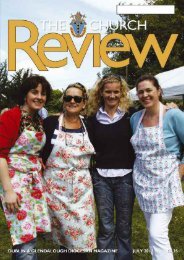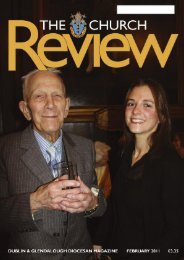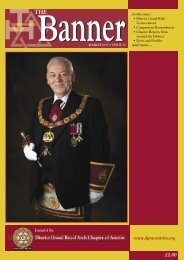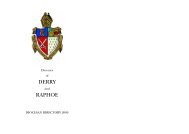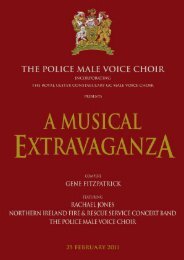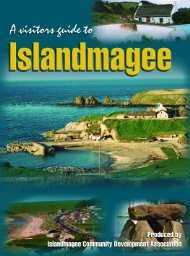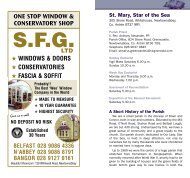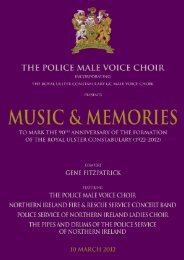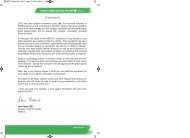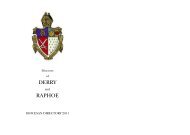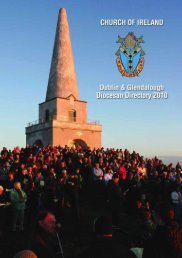around the parishes...
around the parishes...
around the parishes...
Create successful ePaper yourself
Turn your PDF publications into a flip-book with our unique Google optimized e-Paper software.
A DECADE IN WHICH ANARCHY WAS LOOSED<br />
UPON THE WORLD, A TERRIBLE BEAUTY WAS BORN<br />
Patrick Comerford<br />
As we begin a new year, and look<br />
forward to <strong>the</strong> next 12 months, we<br />
should also be aware that we are facing<br />
into a decade of anniversaries, when we<br />
will be faced with <strong>the</strong> commemorations<br />
of events a centenary ago, recalling <strong>the</strong><br />
tumultuous events between 1912 and<br />
1922 that shaped not only Irish identity<br />
but also shaped <strong>the</strong> map of Europe.<br />
It is <strong>the</strong> decade that was marked by <strong>the</strong><br />
demise of Chinese imperial dynasties, World<br />
War I, <strong>the</strong> Armenian Genocide, <strong>the</strong> Gallipoli<br />
landings, <strong>the</strong> Battle of <strong>the</strong> Somme, <strong>the</strong> Russian<br />
Revolution, <strong>the</strong> Balfour Declaration, <strong>the</strong> defeat<br />
of Germany, <strong>the</strong> fall of <strong>the</strong> Hapsburgs, <strong>the</strong><br />
creation of <strong>the</strong> Weimar Republic and <strong>the</strong> Soviet<br />
Union, <strong>the</strong> first non-stop transatlantic flight, <strong>the</strong><br />
collapse of <strong>the</strong> Ottoman Empire, <strong>the</strong> winning of<br />
women’s voting rights, and <strong>the</strong> rise of<br />
Communism and Fascism.<br />
But it was <strong>the</strong> decade too that brought us<br />
<strong>the</strong> modern zipper, stainless steel, and <strong>the</strong> popup<br />
toaster. It was a decade that saw <strong>the</strong><br />
publication of Einstein’s <strong>the</strong>ory of relativity, <strong>the</strong><br />
first US feature film, <strong>the</strong> debut of Charlie<br />
Chaplin, <strong>the</strong> publication of Thomas Mann’s<br />
Death in Venice, DH Lawrence’s Sons and<br />
Lovers and Women in Love and TS Eliot’s The<br />
Waste Land.<br />
For Irish people, this was <strong>the</strong> decade that saw<br />
<strong>the</strong> death of Bram Stoker, <strong>the</strong> author of<br />
Dracula, who was born into a Dublin Church of<br />
Ireland family. It was a decade that saw <strong>the</strong><br />
publication of James Joyce’s Dubliners, Portrait<br />
of <strong>the</strong> Artist as a Young Man, and Ulysses, and of<br />
Pygmalion by George Bernard Shaw. And it was<br />
a decade too that was marked by <strong>the</strong> sinking of<br />
<strong>the</strong> Titanic and <strong>the</strong> Lusitania.<br />
‘The centre cannot hold’<br />
The world was so changed and transformed<br />
WB Yeats could open his poem The Second<br />
Coming with <strong>the</strong>se lines about Europe in <strong>the</strong><br />
aftermath of World War I:<br />
Turning and turning in <strong>the</strong> widening gyre<br />
The falcon cannot hear <strong>the</strong> falconer;<br />
Things fall apart; <strong>the</strong> centre cannot hold;<br />
Mere anarchy is loosed upon <strong>the</strong> world,<br />
The blood-dimmed tide is loosed, and everywhere<br />
The ceremony of innocence is drowned;<br />
The best lack all conviction, while <strong>the</strong> worst<br />
Are full of passionate intensity.<br />
Towards <strong>the</strong> end of that decade, <strong>the</strong> Church<br />
of Ireland was living with <strong>the</strong> consequences of a<br />
half century of disestablishment. But <strong>the</strong> Church<br />
was more concerned with social political<br />
upheaval on this island, and <strong>the</strong> way we were<br />
tearing ourselves apart as a people. Irish identity<br />
was changed violently over that ten-year period,<br />
so that <strong>the</strong> lines by Yeats about <strong>the</strong> leaders of<br />
<strong>the</strong> Easter Rising in 1916 could be applied to <strong>the</strong><br />
whole island and <strong>the</strong> whole population:<br />
All changed, changed utterly:<br />
A terrible beauty is born.<br />
It was a decade that saw <strong>the</strong> reconstruction<br />
of Irish identity through <strong>the</strong> creation of myths<br />
that by-passed <strong>the</strong> facts, even as <strong>the</strong> main<br />
actors in those myths were still alive.<br />
Language and identity<br />
It is forgotten that modern Irish nationalism<br />
had its incubation and gestation in <strong>the</strong> revival of<br />
<strong>the</strong> Irish language – a revival in which <strong>the</strong> main<br />
players included Dr Douglas Hyde, <strong>the</strong> son of a<br />
4 CHUrCH revIew<br />
Looking down <strong>the</strong> Liffey towards Liberty<br />
Hall… would <strong>the</strong> key players in <strong>the</strong><br />
events 100 years ago recognise <strong>the</strong><br />
Ireland of today?<br />
Dublin Castle… <strong>the</strong> seat of Government<br />
until 1922.<br />
Left: The Abbey Theatre contributed to<br />
<strong>the</strong> cultural expressions of Irish<br />
nationalism. Right: Jim Larkin… “The<br />
great appear great because we are on<br />
our knees: Let us rise.”<br />
James Connolly was born in Scotland<br />
and married a member of <strong>the</strong> Church of<br />
Ireland.<br />
Church of Ireland rector, and Dr Eleanor Hull<br />
in hymns such as Be thou my vision (643).<br />
The artistic expressions of <strong>the</strong> new<br />
nationalism were found in <strong>the</strong> Abbey Theatre,<br />
founded by Lady Gregory, WB Yeats and<br />
George Russell (AE), <strong>the</strong> poetry of Yeats and<br />
<strong>the</strong> plays of Sean O’Casey – all members of <strong>the</strong><br />
Church of Ireland.<br />
Since 1916, <strong>the</strong> leaders of <strong>the</strong> Easter Rising in<br />
Dublin have been transformed into ei<strong>the</strong>r<br />
working class heroes or <strong>the</strong> personifications of<br />
what it is to be Green, Gaelic, Catholic and<br />
The Rotunda in Dublin… a venue for<br />
many of <strong>the</strong> political meetings and<br />
heated debates on all sides in <strong>the</strong><br />
decade between 1912 and 1922.<br />
Charles Stewart Parnell, founder of <strong>the</strong><br />
Irish Parliamentary Party, influenced a<br />
later generation of nationalists.<br />
Irish. But <strong>the</strong> myths that have been created by<br />
those who have a blinkered vision of what it is<br />
to be Irish betray <strong>the</strong> truths of history.<br />
Who remembers today that Pádraig Pearse<br />
was born Patrick Henry Pearse, <strong>the</strong> son of a<br />
Birmingham Unitarian who had come to Dublin<br />
from England as part of <strong>the</strong> Victorian arts-andcrafts<br />
movement? There are o<strong>the</strong>r myths<br />
surrounding Pearse, including one that he was<br />
“President of <strong>the</strong> Provisional Government,” a<br />
post that may have been held instead by<br />
Thomas Clarke. There is no manuscript version<br />
of <strong>the</strong> 1916 Proclamation, but on all printed<br />
versions, <strong>the</strong> leaders’ names are not printed in<br />
alphabetical order, so that Pearse’s name is<br />
listed fourth, after Thomas Clarke, Sean Mac<br />
Diarmada and Thomas MacDonagh.<br />
Ironically, Clarke was not born in Ireland but<br />
in an army barracks on <strong>the</strong> Isle of Wight in<br />
England, where his fa<strong>the</strong>r was a soldier in <strong>the</strong><br />
British army. Thomas MacDonagh had a middle<br />
class education in Rockwell College, Co<br />
Tipperary, and was a lecturer in English in UCD.<br />
In 1912, he married Muriel Gifford, a member<br />
of a well-known Church of Ireland family in<br />
Dublin. Éamonn Ceannt, an accountant, was<br />
born Edward Thomas Kent, <strong>the</strong> son of an officer<br />
in <strong>the</strong> Royal Irish Constabulary.



